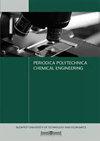Cellulose, Cellulose Benzoate and Cellulose Citrate from Screw Pine (Pandanus tectorius) Leaves as PVDF Filler for Improved Permeability and Anti-fouling Properties
IF 1.8
4区 工程技术
Q3 ENGINEERING, CHEMICAL
引用次数: 1
Abstract
Cellulose was isolated from screw pine (Pandanus tectorius) leaves through an alkalization and bleaching process and synthesized into cellulose benzoate and cellulose citrate. Cellulose, cellulose benzoate, and cellulose citrate were introduced to polyvinylidene fluoride (PVDF) matrix as fillers via blending-phase inversion method to improve PVDF membrane permeability and anti-fouling properties. The effect of cellulose, cellulose benzoate, and cellulose citrate fillers on PVDF membrane hydrophilicity, permeability, selectivity, anti-fouling properties, and morphology was investigated. The result demonstrates that the PVDF membrane's hydrophilicity, permeability, and anti-fouling properties were improved by the addition of filler. With the addition of 0.3% of cellulose, cellulose citrate, and cellulose benzoate, water permeability in PVDF was doubled. PVDF membrane rejection of methylene blue increased up to 86, 85 and 82%, respectively, with the addition of 0.3% cellulose, cellulose citrate, and cellulose benzoate. Anti-fouling properties value increased up to 89% in 0.3% cellulose citrate addition. These results indicated that cellulose, cellulose benzoate, and cellulose citrate from screw pine leaves are excellent for PVDF membrane fillers which are comparable with other reported membranes.松叶纤维素、苯甲酸纤维素和柠檬酸纤维素用作PVDF填料以提高透气性和防污性能
通过碱化和漂白工艺从螺旋松(Pandanus tectorius)叶片中分离纤维素,合成苯甲酸纤维素和柠檬酸纤维素。通过共混相转化法,将纤维素、苯甲酸纤维素和柠檬酸纤维素作为填料引入聚偏氟乙烯(PVDF)基质中,以提高PVDF膜的透性和抗污性能。研究了纤维素、苯甲酸纤维素和柠檬酸纤维素填料对PVDF膜亲水性、渗透性、选择性、抗污性能和形态的影响。结果表明,填料的加入提高了PVDF膜的亲水性、透气性和抗污染性能。添加0.3%的纤维素、柠檬酸纤维素和苯甲酸纤维素后,PVDF的透水性提高了一倍。当添加0.3%的纤维素、柠檬酸纤维素和苯甲酸纤维素时,PVDF膜对亚甲基蓝的去除率分别提高了86%、85%和82%。添加0.3%的柠檬酸纤维素,其防污性能值提高89%。这些结果表明,从松叶中提取的纤维素、苯甲酸纤维素和柠檬酸纤维素是极好的PVDF膜填料,与其他报道的膜相当。
本文章由计算机程序翻译,如有差异,请以英文原文为准。
求助全文
约1分钟内获得全文
求助全文
来源期刊

Periodica Polytechnica Chemical Engineering
ENGINEERING, CHEMICAL-
CiteScore
3.10
自引率
7.70%
发文量
44
审稿时长
>12 weeks
期刊介绍:
The main scope of the journal is to publish original research articles in the wide field of chemical engineering including environmental and bioengineering.
 求助内容:
求助内容: 应助结果提醒方式:
应助结果提醒方式:


